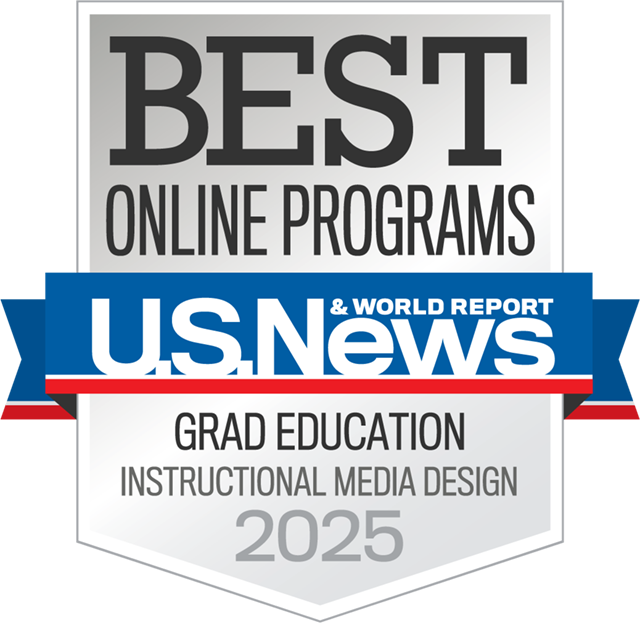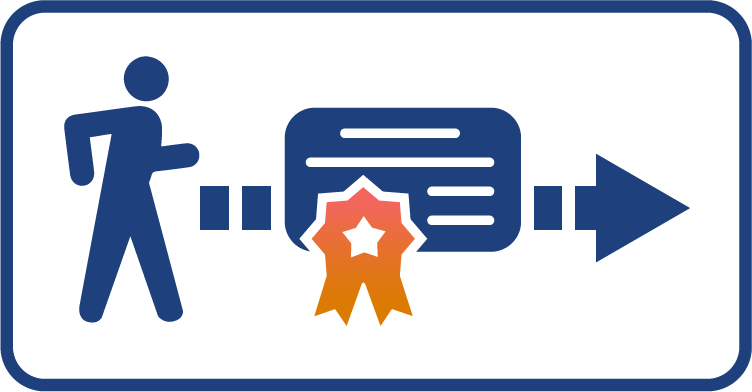100% Online
Complete your Penn State course work at your own pace and 100% online.
Application deadline
Credits and costs
Nationally Recognized

Expand Your Instructional Design Skills with Technology
Incorporate technology to effectively engage students and trainees.
Evaluate the impact of technology on learning.
Improve learner performance while enhancing the quality of learning experiences.
Develop lesson plans and resources using current theories of instruction.
Customize Your Course List
Customize Your Course List
The learning, design, and technology courses will challenge you to apply what you learn to practical, real-world problems and encourage you to blend your personal and professional interests into your course work.
Your courses will go beyond ADDIE (the famed analysis, design, develop, implement, and evaluate model of instructional design) so you can be prepared to enrich learning environments with educational technology.
Penn State's online Master of Education in Learning, Design, and Technology emphasizes the evaluation and improvement of technology's impact on the learning process and can provide you with the technical and research skills to analyze the effectiveness of technology integration in your school, organization, or corporation.
You must complete 30 credits of course work, plus a noncredit unit on scholarship and research integrity and a noncredit capstone portfolio that will be reviewed by your adviser at the end of the program. At least 18 credits of course work must be at the 500 or 800 level, and a minimum of 6 credits must be at the 500 level.
Core Courses (9 credits)
- 3credits
Application of a systematic learning design model relevant to all learning contexts and audiences for analyzing instructional problems, developing validated resources, and implementing practical solutions.
- 3credits
This course examines emerging web technologies and explores their application to learning and education.
- 3credits
Designing learning environments based on constructivist principles of learning that provide modeling, coaching, and scaffolding.
Recommended Courses (select 21 credits)
- 3credits
Prepares teachers to evaluate the effects of technology use.
- 3credits
Explores the role of gaming, video gaming, and simulations in educational contexts including K–12, corporate, informal, non-profit, and higher education.
- 3credits
Explores key principles of effective online instruction for K–12 learners, including tools for teaching online, creation of an online environment, strategies for collaboration, supporting learners with special needs, among other topics.
- 3credits
Surveys contemporary readings, software, and hardware to explore the intersection of learning, teaching, and technology use. Students analyze contemporary uses of technology to support learning through readings, multimedia, and hands-on experience.
- 3credits
Research on learning with mobile computers and models for mobile computer integration for K–12 schools, community organizations, and universities.
- 3credits
Examines a range of skills, processes, and theories for designing and developing interactive educational materials.
- 3credits
Examines the costs and benefits of technology use, emerging research topics on technology-enhanced learning, and important tradeoffs that need to be considered when designing technology-enhanced learning contexts.
- 3credits
Guides learners to read, reflect on, and discuss various historical and contemporary learning theories and frameworks within the area of Learning, Design, and Technology, and their particular importance for learning designers and researchers.
- 3credits
Explores the historical roots of makerspaces and hobbyist learning activities, as well as the changing landscape of making, content creation, and constructionist activities in education.
- 3credits
Practical design of instructor-facilitated online lessons taking advantage of the affordances and within the constraints of course management systems.
- 3credits
Provides technology designers, educators, and researchers with a practice-oriented approach to ethics in education technology.
- 3credits
Focuses on historic and contemporary issues relevant to designing and researching games (digital and non-digital), and related media and online communities for learning.
Course Availability
If you're ready to see when your courses will be offered, visit our public LionPATH course search (opens in new window) to start planning ahead.
Advance Your Career

Advance Your Career
You can use the knowledge gained from this program and the support of Penn State career resources to pursue careers in a variety of fields, depending on your goals.
Job Titles Related to This Degree
The following roles are often held by people with this type of degree:
- E-Learning Developer
- Educational Technology Specialist
- Instructional Designer
- Instructional Systems Specialist
- Learning Development Specialist
Employment Outlook for Occupational Fields Related to This Degree
Estimates of employment growth and total employment are provided by the U.S. Bureau of Labor Statistics and are subject to change. While these occupations are often pursued by graduates with this degree, individual outcomes may vary depending on a variety of factors. Penn State World Campus cannot guarantee employment in a given occupation.
Training and Development Specialists
Instructional Coordinators
Librarians and Media Collections Specialists
Career Services to Set You Up for Success

From the day you're accepted as a student, you can access resources and tools provided by Penn State World Campus Career Services to further your career. These resources are beneficial whether you're searching for a job or advancing in an established career.
- Opportunities to connect with employers
- Career counselor/coach support
- Occupation and salary information
- Internships
- Graduate school resources
On-Demand Webinar
Our on-demand Master of Education in Learning, Design, and Technology Webinar can provide you additional insight into the curriculum if you are unable to attend our upcoming events.
Ready to Learn More?
Get the resources you need to make informed decisions about your education. Request information on this program and other programs of interest by completing this form.
Ready to take the next step toward your Penn State master's degree?
Costs and Financial Aid
Costs and Financial Aid
Learn about this program's tuition, fees, scholarship opportunities, grants, payment options, and military benefits.
Costs and Financial Aid
Graduate Tuition
Graduate tuition is calculated based on the number of credits for which you register. Tuition is due shortly after each semester begins and rates are assessed every semester of enrollment.
2024–25 Academic Year Rates
| How many credits do you plan to take per semester? | Cost |
|---|---|
| 11 or fewer | $1,027 per credit |
| 12 or more | $12,325 per semester |
2025–26 Academic Year Rates
| How many credits do you plan to take per semester? | Cost |
|---|---|
| 11 or fewer | $1,037 per credit |
| 12 or more | $12,448 per semester |
Financial Aid and Military Benefits
Some students may qualify for financial aid. Take the time to research financial aid, scholarships, and payment options as you prepare to apply. Federal financial aid may only be used to pay for credits used to satisfy program requirements.
Military service members, veterans, and their spouses or dependents should explore these potential military education benefits and financial aid opportunities, as well.
Additional Cost of Attendance Details
To view the detailed list of cost of attendance elements:
- visit the Tuition Information site
- click the plus sign to expand the table
- select a semester from the World Campus row
Technical Requirements
Review the technical requirements for this program.
Earn a Valuable Credential along the Way

Earn a Valuable Credential along the Way
Show mastery of specific subjects before your degree is complete. Thanks to shared courses across programs, students can often earn a certificate along with their degree in less time than if they earned them separately.
Certificate Programs Related to This Degree
Credit toward the following certificates can be earned while completing this degree program:
Learn how to effectively integrate instructional technology into your curriculum to enhance your students' learning outcomes by enrolling in our online educational technology certificate program.
Learn more about the Postbaccalaureate Certificate in Educational Technology IntegrationLearn to use course design and innovative technology to create and deliver impactful online teaching and learning experiences. This 12-credit e-learning design certificate program takes a project-based approach to instructional design.
Learn more about the Postbaccalaureate Certificate in e-Learning DesignOptimize Your Educational Design
Learn to perform critical analysis of your educational and training programs, using cost-benefit and ROI analyses, audience analysis, and task analysis to guide the customization of your design work for specific content, audiences, and contexts.
Instructional Design beyond K–12
The strategies learned in this program can be used by trainers and instructional designers from many different backgrounds who are interested in a learning-centered approach beyond a traditional school setting.
Learn best practices in the development and delivery of online, hybrid, and face-to-face curriculum and successfully incorporate the use of the internet and technology in teaching and learning at your institution.
Learn core skills including design of learning management systems, implementation of mobile technologies for learning, design of informal learning experiences, intentional engagement of social learning experiences, and the implementation of technology-enhanced learning.
Directly apply the experience and skills developed through your courses to the work you are doing in your units. You can learn how to create engaging learning experiences by thinking beyond the simple delivery of training content.
Act 48–Approved
Penn State is an Act 48–approved provider for Pennsylvania educators, so the courses for the Master of Education in Learning, Design, and Technology may count toward your professional development hours.
Please note that this program does not lead to initial teacher certification or the Pennsylvania Department of Education Instructional Technology Specialist Certificate. However, this program may help you to renew your teacher certification. Check with your state's Department of Education for exact requirements for recertification.
Set Your Own Pace

Set Your Own Pace
Whether you are looking to finish your program as quickly as possible or balance your studies with your busy life, Penn State World Campus can help you achieve your education goals. Many students take one or two courses per semester.
Our online courses typically follow a 12- to 15-week semester cycle, and there are three semesters per year (spring, summer, and fall). If you plan to take a heavy course load, you should expect your course work to be your primary focus and discuss your schedule with your academic adviser.
To Finish Your Degree in One to Two Years
- Take 3–4 courses each semester
To Finish Your Degree in Two to Three Years
- Take 2–3 courses each semester
To Finish Your Degree in Three to Four Years
- Take 1 course each semester
Timelines may vary based on course availability.
Convenient Online Format
This program's convenient online format gives you the flexibility you need to study around your busy schedule. You can skip the lengthy commute without sacrificing the quality of your education and prepare yourself for more rewarding career opportunities without leaving your home.
A Trusted Leader in Online Education

Penn State has a history of more than 100 years of distance education, and World Campus has been a leader in online learning for more than two decades. Our online learning environment offers the same quality education that our students experience on campus.
How to Apply to Penn State

How to Apply to Penn State
Apply by June 15 to start August 25
Application Instructions
Deadlines and Important Dates
Complete your application and submit all required materials by the appropriate deadline. Your deadline will depend on the semester you plan to start your courses.
Fall Deadline
Apply by June 15 to start August 25Spring Deadline
Apply by November 1 to start January 12Summer Deadline
Apply by April 1, 2026, to start May 18, 2026
Steps to Apply
For admission to the J. Jeffrey and Ann Marie Fox Graduate School, an applicant must hold either (1) a baccalaureate degree from a regionally accredited U.S. institution or (2) a tertiary (postsecondary) degree that is deemed comparable to a four-year bachelor's degree from a regionally accredited U.S. institution. This degree must be from an officially recognized degree-granting institution in the country in which it operates.
You will need to upload the following items as part of your application:
Official transcripts from each institution attended, regardless of the number of credits or semesters completed. Transcripts not in English must be accompanied by a certified translation. If you are a Penn State alum, you do not need to request transcripts for credits earned at Penn State but must list Penn State as part of your academic history.
Test Scores — GRE/MAT test scores are no longer an application requirement.
English Proficiency — The language of instruction at Penn State is English. With some exceptions, international applicants must take and submit scores for the Test of English as a Foreign Language (TOEFL) or International English Language Testing System (IELTS). Minimum test scores and exceptions are found in the English Proficiency section on the Fox Graduate School's "Requirements for Graduate Admission" page. Visit the TOEFL website& for testing information. Penn State's institutional code is 2660.
References (3) — You will need to initiate the process through the online application by entering names, email addresses, and mailing addresses of three references. Upon submission of your application, an email will be sent to each reference requesting their online submission of a letter of recommendation.
The letter should address the nature and quality of the applicant’s professional/workplace performance and an assessment of the applicant’s readiness to pursue online graduate degree study. The references must be provided by professional colleagues such as coworkers, supervisors, academic instructors or advisers, classmates, business partners, etc. We are unable to accept references from family members, personal friends/acquaintances, or current LDT program faculty members. Please inform all recommenders they must submit the reference form online in order for your application to be complete.
Program-Specific Questions/Materials
Résumé or Vita — Concisely describe your academic and professional history, achievements, and skills relevant to the LDT program and the field of education.
Statement of Purpose — 750 words or less explaining why you want to enter the master's program. This statement should include:
- your career goals and an explanation of how your prospective degree in LDT will help you to achieve your goals
- your professional background and your reasons for seeking a graduate degree in LDT
- how your professional and academic backgrounds qualify you for acceptance to the program
- how your professional interests correspond with the course work topics and faculty expertise of the program
- any other information that may help us to consider your application.
Writing Samples — Submit a 300- (minimum) to 400- (maximum) word review of an article or report published in a recent professional journal of your choice. The selected publication should address a contemporary educational issue related to your academic interests. The review should include a summary of key findings and a discussion of the findings’ current or future impact to the field of education. The review must be written and edited primarily by the applicant without substantial assistance provided by another person, software, or hardware. Please be sure to include the article that is being reviewed.
To begin the online application, you will need a Penn State account.
Create a New Penn State Account
If you have any problems during this process, contact an admissions counselor at [email protected].
Please note: Former Penn State students may not need to complete the admissions application or create a new Penn State account. Please visit our Returning Students page for instructions.
You can begin your online application at any time. Your progress within the online application system will be saved as you go, allowing you to return at any point as you gather additional information and required materials.
- Choose Enrollment Type: "Degree Admission"
- Choose "WORLD CAMPUS" as the campus
Checking Your Status
You can check the status of your application by using the same login information established for the online application form.5. Complete the application.
Admissions Help
If you have questions about the admissions process, contact an admissions counselor at [email protected].
Contact Us

Contact Us
Have questions or want more information? We're happy to talk.
To learn more about the Master of Education in Learning, Design, and Technology, please contact:
World Campus Admissions Counselors
Phone: 814-863-5386
[email protected]
Edie Worley
Academic Program Coordinator
Department of Learning, Design and Technology
301 Keller Building
University Park, PA 16802
Phone: 814-863-2596
[email protected]
Learn from the Best
Learn from the Best
Penn State World Campus has partnered with the Penn State College of Education to offer programs in learning design. Taught by the same nationally recognized faculty who teach on campus, these programs are designed to help you incorporate the internet and technology in your professional setting.
Faculty
Ty Hollett
- DegreePh.D., Language, Literacy, and Culture, Vanderbilt University
- DegreeM.EdT., Education, University of Hawaii
- DegreeM.A., English, Penn State
- DegreeB.A., English, DePauw University
Dr. Ty Hollett's research examines the intersection of out-of-school learning, youth culture, and digital media. Specifically, he studies and designs informal, media-rich learning settings for youth in order to support innovative teaching and learning. As an effort to disrupt container-like models of teaching and learning, his research responds to the ongoing development of interest-driven learning opportunities for youth within — and beyond — such settings as home, libraries, schools, and city streets.
ChanMin Kim
- DegreePh.D., Instructional Systems, Florida State University
- DegreeM.Ed., Educational Media and Technology, Boston University
- DegreeM.Ed., Educational Technology, Yonsei University
- DegreeB.A., Special Education, Ewha Womans University
ChanMin Kim is an associate professor of learning, design, and technology and educational psychology. She researches various designs for improving equity through education. Her research projects involve culturally responsive use of simulations, robots, and programming platforms in a variety of learning contexts. She has taught EDTEC/LDT 561: Measuring the Impact of Technology on Learning and LDT 832: Designing e-Learning within Course Management Systems for World Campus.
Susan M. Land
- DegreePh.D., Instructional Systems Design, Florida State University
- DegreeM.S., Instructional Systems Design, Florida State University
- DegreeB.S., Psychology, Florida State University
Susan M. Land serves as the head of the Department of Learning and Performance Systems within the Penn State College of Education and is a professor in the learning, design, and technology program. Land’s research investigates frameworks for the design of open-ended, technology-enhanced learning environments. Her research is currently funded by the National Science Foundation to study mobile, augmented reality (AR) technologies to support science learning in outdoor community spaces.
Natalie Rae
- DegreePh.D., Learning, Teaching, and Diversity, Vanderbilt University
- DegreeM.Ed., Physics Education, Rutgers University
- DegreeB.S., Bioenvironmental Engineering, Rutgers University
Dr. Natalie Rae is an assistant professor of learning, design, and technology whose research explores the political dimensions of STEM teaching and learning. Currently, she studies how young people and adults draw on artistic repertoires while engaging in formal and informal STEM to reimagine what counts as disciplinary science learning.
Priya Sharma
- DegreePh.D., Instructional Technology, University of Georgia
- DegreeM.S., Instructional Technology, Bloomsbury University
- DegreeB.Sc., Chemistry, Botany, Zoology, Mt. Carmel College, Bangalore
Dr. Priya Sharma's research and teaching broadly focus on the design and use of emerging technologies for teaching and learning in formal and informal contexts. In formal contexts, she is interested in the design and integration of emerging technologies, including new web technologies, learning analytics, and machine learning to support student learning and engagement and to help facilitators be responsive in their teaching.
Heather Toomey Zimmerman
- DegreePh.D., Learning Sciences, University of Washington
- DegreeM.A., Museology (Museum Studies), University of Washington
- DegreeB.S., Science Communication, Cornell University
Heather Toomey Zimmerman is a professor of education and a learning scientist. Her interests include everyday science learning, environmental education, parent-child interactions (family learning), designing for learning in museums or other informal institutions, and mobile computing with augmented reality. Her prior work experience involved designing and implementing museum programs for families, youths, and community organizations.
News




